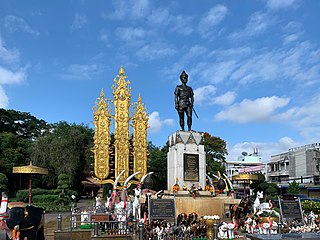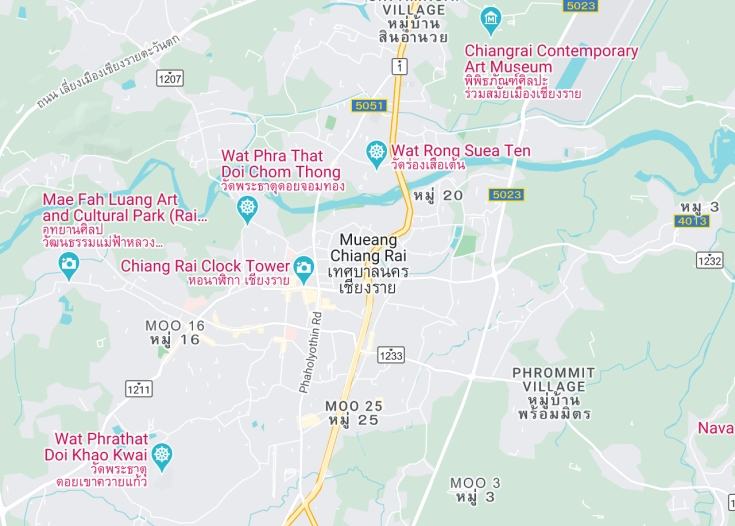Chiang Rai, nestled in the northernmost part of Thailand, offers a refreshing escape from the bustling tourist spots, with its serene landscapes and rich cultural heritage. Known for its majestic temples, including the famous White Temple, and vibrant hill tribe communities, Chiang Rai is a haven for those seeking tranquility amidst nature. The city serves as a gateway to exploring the lush jungles and the serene Mekong River, making it ideal for adventure seekers and culture enthusiasts alike.
Consider visiting during the cool season from November to February for comfortable exploring, as Chiang Rai’s natural and cultural attractions are best enjoyed in milder weather.
Make sure to attend a traditional tea tasting session in the surrounding hills, where locally grown teas offer a unique insight into the agricultural heritage of the region.
Top things to do & see in Chiang Rai
Select the following sights and activities to discover best tickets and tours available in Chiang Rai.
Chiang Rai: A Gateway to Cultural Riches
| Country | Thailand |
| Time in Chiang Rai | GMT+7 |
| Language spoken | Thai |
| Population | 199,699 (source: Thailand’s Statistic Bureau, 2023) |
| Currency | Thai Baht (฿, THB) |
| Airports | Mae Fah Luang – Chiang Rai International Airport (8 mi / 13 km). |
Chiang Rai, a city in northern Thailand, is steeped in cultural, historical, and geographical significance. Known as the gateway to the Golden Triangle, where Laos, Myanmar, and Thailand converge, Chiang Rai boasts a rich tapestry of cultural diversity. Its landscape is marked by rolling hills, majestic rivers, and lush greenery, making it a picturesque setting for adventurers and culture enthusiasts alike.
Historically, Chiang Rai was established in the 13th century as part of the Lanna kingdom and stands out for its unique reflections of Lanna culture. The city is home to various ethnic groups, including the hill tribes, each contributing to the cultural richness through their traditions, textiles, and culinary delights. Temples such as Wat Rong Khun, also known as the White Temple, offer a modern yet traditional take on Buddhist architecture, drawing visitors worldwide with its intricate designs and spiritual ambiance.
The city also promotes sustainability with numerous eco-tourism initiatives that help preserve its natural and cultural heritage. Visitors can experience firsthand the daily lives of local communities, from traditional tea-making to rice farming, all the while contributing to sustainable tourism practices that protect the city’s invaluable resources.
Festivals such as the Chiang Rai Flower Festival and the Songkran Festival are perfect times for tourists to partake in the celebration of local culture, featuring colorful displays, traditional music, and dance performances. Here, the tourist can truly immerse themselves in the local customs and way of life.
Chiang Rai’s commitment to preserving its natural landscapes and historical sites alongside its evolving modern cultural attractions makes it a fascinating destination for travelers looking to enrich their understanding of Thai culture and history.
Where is Chiang Rai?
Chiang Rai is located in the most northern part of Thailand, bordering Laos and Myanmar.
Distances:
| Route | Distance by car | Time by car |
|---|---|---|
| Bangkok to Chiang Rai | 500 miles | 10 hours |
| Chiang Mai to Chiang Rai | 120 miles | 3 hours |
| Phitsanulok to Chiang Rai | 250 miles | 5 hours |
What is Chiang Rai famous for?
Chiang Rai is renowned for its spectacular temples, diverse ethnic cultures, and scenic natural landscapes, making it a prime destination for cultural and ecotourism.
History
Before 1262: Prehistoric and Early Tribal Communities
The area now known as Chiang Rai has seen human activity dating back to prehistoric times. It was originally settled by various indigenous tribes who were primarily involved in local agriculture and trade across the rugged terrain.
1262-1786: The Lanna Kingdom
Chiang Rai was founded in 1262 by King Mengrai as part of the Lanna Kingdom. During this period, the city served as the capital before the establishment of Chiang Mai. It was a significant center for culture and religion in northern Thailand, renowned for its craftsmanship and agricultural products.
1786-1899: Under Burmese Rule and Later Siam
Following a period of Burmese occupation, Chiang Rai became part of Siam with the efforts of King Rama I and other Siamese nobles who aimed to unify the region under Thai rule. This era was marked by a series of administrative reforms aimed at integrating Chiang Rai into the greater Thai kingdom.
1900-Present: Modern Developments and Growth
In the 20th century, Chiang Rai underwent significant transformations with the introduction of modern infrastructure, such as roads and education institutions. The region has become increasingly connected to the rest of Thailand and the world, developing a vibrant tourism industry while preserving its rich history and cultural heritage.
Visit Chiang Rai
What to see and do in Chiang Rai
Chiang Rai, the northernmost province of Thailand, offers a blend of cultural and natural attractions that invite exploration. Key sights include the mesmerizing White Temple (Wat Rong Khun) with its unique, contemporary Buddhist art, and the historic Black House (Baan Dam Museum), showcasing traditional Thai architecture and artworks. Nature enthusiasts can visit the tranquil Khun Korn Waterfall or explore the verdant landscapes of Doi Tung and Phu Chi Fa. For an immersive cultural experience, a visit to the hill tribe villages offers a glimpse into the lives of the indigenous communities.
Festivals and Events in Chiang Rai
Chiang Rai is renowned for its vibrant festivals, particularly the Chiang Rai Flower Festival held in December, which features beautiful floral displays, parades, and cultural performances. Another significant event is the Songkran Festival in April, the traditional Thai New Year, marked by water fights and merry-making in a spirited celebration of life and community.
Best time to visit Chiang Rai
The ideal time to visit Chiang Rai is between November and February when the weather is cool and dry, making it perfect for outdoor activities and sightseeing. This period also coincides with many of the city’s cultural festivals and events, providing visitors with a rich, immersive experience.
Is Chiang Rai worth visiting?
Chiang Rai is undoubtedly worth visiting for anyone interested in exploring a region rich with cultural heritage, stunning temples, and breathtaking natural landscapes. The city offers a more relaxed atmosphere compared to its busier neighbor, Chiang Mai, making it ideal for those who wish to experience authentic Thai culture and traditions at a more leisurely pace. The unique local experiences, combined with the friendly locals and excellent cuisine, make Chiang Rai a memorable and enriching destination.
What are the top attractions to visit in Chiang Rai?
Chiang Rai offers a diverse array of attractions that capture both its cultural heritage and natural beauty. Key places to visit include the White Temple (Wat Rong Khun), with its unique, intricate white carvings that shine under the Thai sun. Another must-see is the Blue Temple (Wat Rong Suea Ten), where brilliant blue interiors and elaborate carvings depict Buddhist teachings. The Black House (Baan Dam Museum) provides a stark, thought-provoking contrast with its dark-themed, eclectic art pieces. Nature enthusiasts should not miss a trip to the Golden Triangle, where Thailand, Laos, and Myanmar meet, or to Phu Chi Fah, for panoramic sunrise views.
What are the best activities for families in Chiang Rai?
Chiang Rai is family-friendly with activities that cater to all ages. Families can enjoy exploring the Singha Park, which offers biking, zip-lining, and a tea plantation tour, perfect for a day outdoors. At the Chiang Rai Beach, or locally known as Pat Mai Beach, families can relax by the river or enjoy a picnic. Another great family activity is visiting the Mae Fah Luang Art and Cultural Park, which features beautiful gardens and an impressive collection of Lanna artifacts. For those interested in adventure, elephant camps around the city offer ethical elephant interactions and trekking.
What local foods should I try in Chiang Rai?
Chiang Rai’s cuisine offers a tapestry of flavors distinct from other parts of Thailand. A must-try is Khao Soi, a creamy coconut curry noodle soup with a choice of chicken or beef, topped with crispy noodles. For a local snack, try Sai Oua, a northern Thai sausage that is fragrant with herbs and spices. Another regional specialty is Nam Ngiao, a tangy tomato-based noodle soup with pork or beef, seasoned with local spices. Don’t miss sampling Kanom Jeen Nam Ngiao, which is an adaptation of the dish served with fresh rice noodles.
Where can I find traditional handicrafts in Chiang Rai?
Traditional handicrafts in Chiang Rai are best found at the local markets and village cooperatives. The Night Bazaar, located in the heart of the city, is an excellent place to find hand-woven textiles, silver jewelry, and wood carvings, all crafted by local artisans. Another notable spot is the Saturday Walking Street on Thanalai Road, which offers a vibrant atmosphere and a wider range of crafts and homemade goods. For a more immersive experience, visit the hill tribe villages around Chiang Rai, such as the Akha, Yao, or Lahu villages, where you can observe artisans at work and purchase unique handcrafted items directly.
Are there any eco-tours available in Chiang Rai?
Eco-tourism is thriving in Chiang Rai, with numerous tours available that focus on sustainable travel and nature conservation. Tour companies offer guided treks through the lush jungles of Northern Thailand, home to diverse fauna and flora, often including visits to remote hill tribe villages. Bird watching tours are popular in areas like Doi Luang National Park. For those interested in agriculture, some tours visit organic farms and tea plantations, showcasing sustainable farming practices. Additionally, river tours on the Kok River provide a unique perspective of the region’s natural beauty and local life along the riverbanks.
What are the best places for nature and wildlife experiences in Chiang Rai?
Chiang Rai is surrounded by natural landscapes that provide sanctuary to diverse wildlife. Doi Tung, known for its beautiful garden and mountain scenery, is an excellent spot for hiking and enjoying cooler weather. Doi Luang National Park offers trails that meander through thick forests, waterfalls, and overlooks where wildlife sightings are common. For a closer encounter with animals, the Chiang Rai Elephant Sanctuary offers a responsible way to interact with elephants in a natural setting. Additionally, the Mae Kok River is a great place for bird watching and spotting other riverine wildlife on a boat trip.
How can I experience the local culture in Chiang Rai?
To truly engage with the local culture in Chiang Rai, participate in community and traditional activities. Visit during one of the many festivals, like the Flower Festival in December or Songkran in April, to see the city alive with cultural celebrations, including parades and traditional music and dance performances. Take a cooking class to learn about northern Thai cuisine or visit a local market with a guide who can explain the different foods and customs. Temples, such as Wat Phra Kaew and Wat Phra That Doi Chom Thong, offer insights into Buddhist practices and the spiritual lifestyle of the locals.
What are some relaxing ways to spend a day in Chiang Rai?
For a relaxing day in Chiang Rai, consider these serene activities. Start your morning with a calm boat ride on the Mae Kok River, enjoying the soft light and cooler weather. For art and nature lovers, spend a few hours wandering through the Mae Fah Luang Art and Culture Park, which combines artistic history with beautiful landscapes. Alternatively, indulge in a traditional Thai massage at one of the many spas in the city for some rejuvenation. End your day by watching the sunset at a riverside restaurant, sampling local dishes and soaking in the peaceful ambiance of Chiang Rai.









